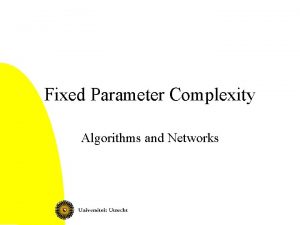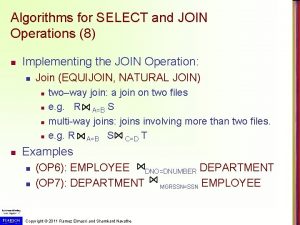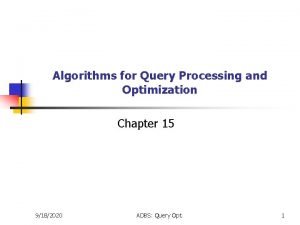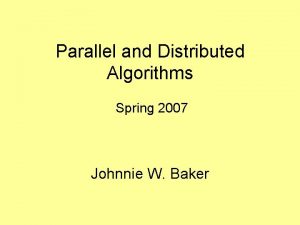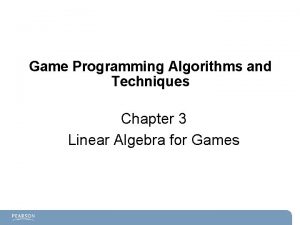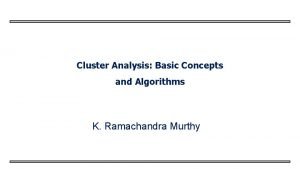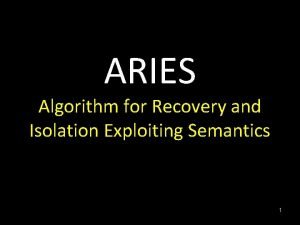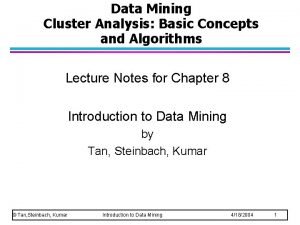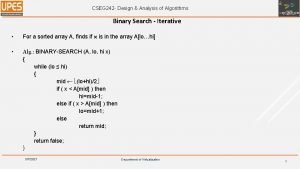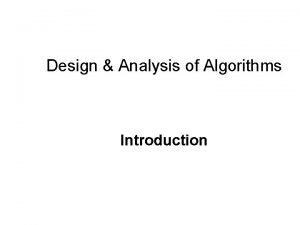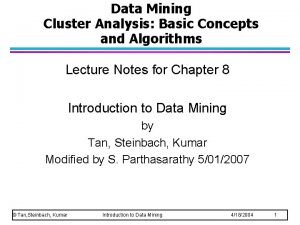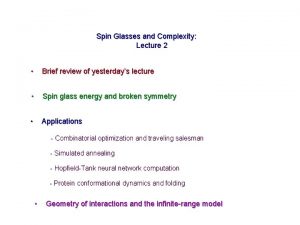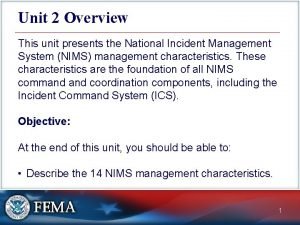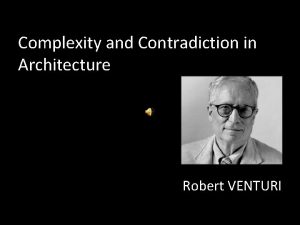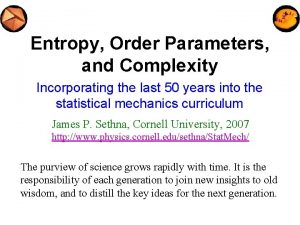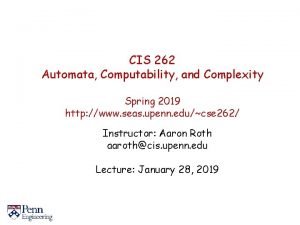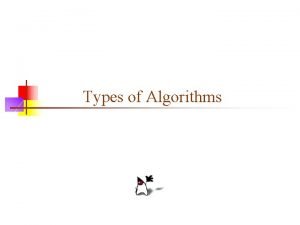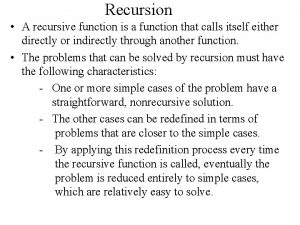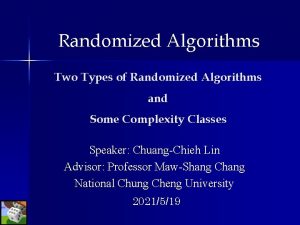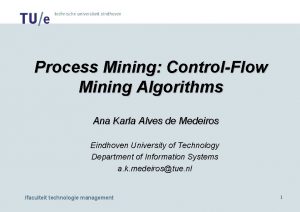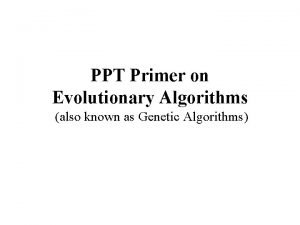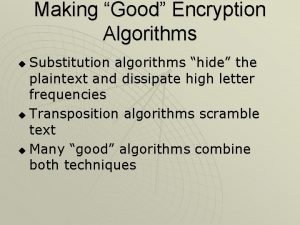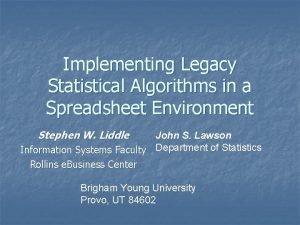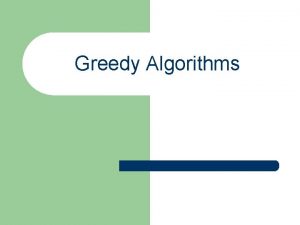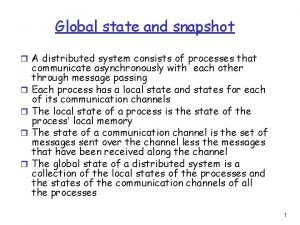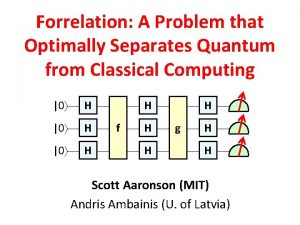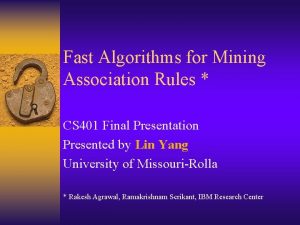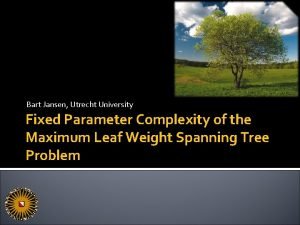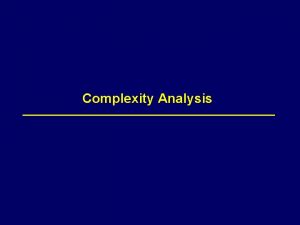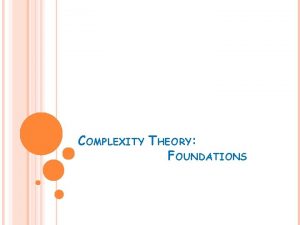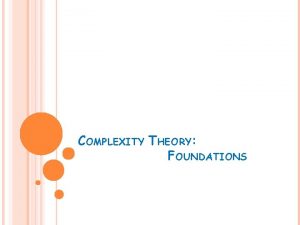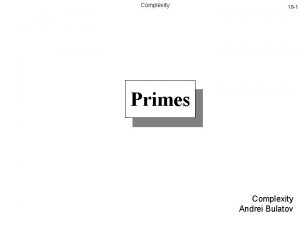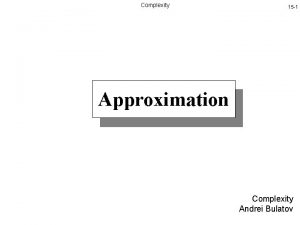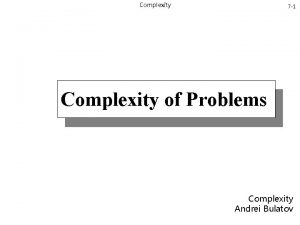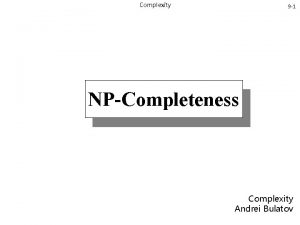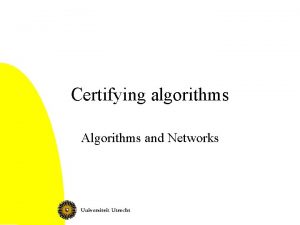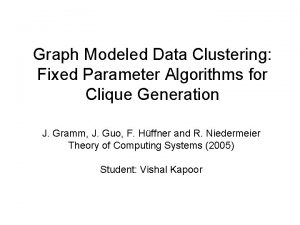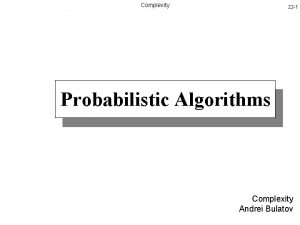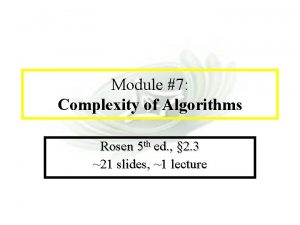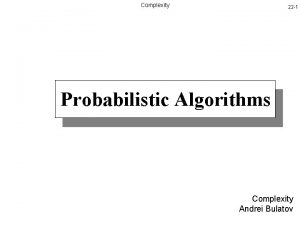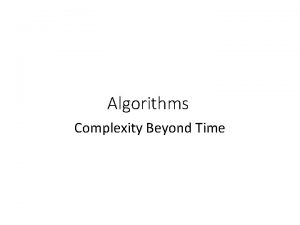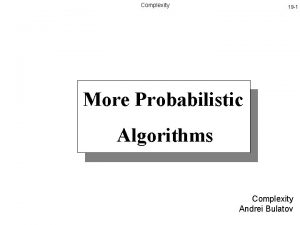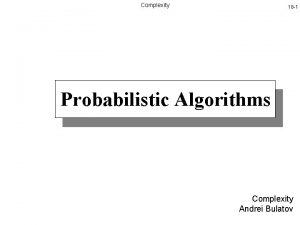Fixed Parameter Complexity Algorithms and Networks Fixed parameter










![Hard problems • Complexity classes – FPT Í W[1] Í W[2] Í … W[i] Hard problems • Complexity classes – FPT Í W[1] Í W[2] Í … W[i]](https://slidetodoc.com/presentation_image/48240106785dd47ce7d73191bb79ce40/image-11.jpg)
![Examples of hard problems • Clique and Independent Set are W[1]-complete • Dominating Set Examples of hard problems • Clique and Independent Set are W[1]-complete • Dominating Set](https://slidetodoc.com/presentation_image/48240106785dd47ce7d73191bb79ce40/image-12.jpg)

























![Consequence • If a problem is W[1]-hard, it has no kernel, unless FPT=W[1] • Consequence • If a problem is W[1]-hard, it has no kernel, unless FPT=W[1] •](https://slidetodoc.com/presentation_image/48240106785dd47ce7d73191bb79ce40/image-38.jpg)














































- Slides: 84

Fixed Parameter Complexity Algorithms and Networks

Fixed parameter complexity • Analysis what happens to problem when some parameter is small • Definitions • Fixed parameter tractability techniques – Branching – Kernelisation – Other techniques 2 Fixed Parameter Complexity

Motivation • In many applications, some number can be assumed to be small – Time of algorithm can be exponential in this small number, but should be polynomial in usual size of problem 3 Fixed Parameter Complexity

Parameterized problem • Given: Graph G, integer k, … • Parameter: k • Question: Does G have a ? ? ? of size at least (at most) k? – Examples: vertex cover, independent set, coloring, … 4 Fixed Parameter Complexity

Examples of parameterized problems (1) Graph Coloring Given: Graph G, integer k Parameter: k Question: Is there a vertex coloring of G with k colors? (I. e. , c: V ® {1, 2, …, k} with for all {v, w}Î E: c(v) ¹ c(w)? ) • NP-complete, even when k=3. 5 Fixed Parameter Complexity

Examples of parameterized problems (2) Clique Given: Graph G, integer k Parameter: k Question: Is there a clique in G of size at least k? • Solvable in O(nk) time with simple algorithm. Complicated algorithm gives O(n 2 k/3). Seems to require W(nf(k)) time… 6 Fixed Parameter Complexity

Examples of parameterized problems (3) Vertex cover Given: Graph G, integer k Parameter: k Question: Is there a vertex cover of G of size at most k? • Solvable in O(2 k (n+m)) time 7 Fixed Parameter Complexity

Fixed parameter complexity theory • To distinguish between behavior: ØO( f(k) * nc) ØW( nf(k)) • Proposed by Downey and Fellows. 8 Fixed Parameter Complexity

Parameterized problems • Instances of the form (x, k) – I. e. , we have a second parameter • Decision problem (subset of {0, 1}* x N ) 9 Fixed Parameter Complexity

Fixed parameter tractable problems • FPT is the class of problems with an algorithm that solves instances of the form (x, k) in time p(|x|)*f(k), for polynomial p and some function f. 10 Fixed Parameter Complexity
![Hard problems Complexity classes FPT Í W1 Í W2 Í Wi Hard problems • Complexity classes – FPT Í W[1] Í W[2] Í … W[i]](https://slidetodoc.com/presentation_image/48240106785dd47ce7d73191bb79ce40/image-11.jpg)
Hard problems • Complexity classes – FPT Í W[1] Í W[2] Í … W[i] Í … Í W[P] – FPT is ‘easy’, all others ‘hard’ – Defined in terms of Boolean circuits – Problems hard for W[1] or larger class are assumed not to be in FPT • Compare with P / NP 11 Fixed Parameter Complexity
![Examples of hard problems Clique and Independent Set are W1complete Dominating Set Examples of hard problems • Clique and Independent Set are W[1]-complete • Dominating Set](https://slidetodoc.com/presentation_image/48240106785dd47ce7d73191bb79ce40/image-12.jpg)
Examples of hard problems • Clique and Independent Set are W[1]-complete • Dominating Set is W[2]-complete • Version of Satisfiability is W[1]-complete – Given: set of clauses, k – Parameter: k – Question: can we set (at most) k variables to true, and al others to false, and make all clauses true? 12 Fixed Parameter Complexity

Techniques for showing fixed parameter tractability • • 13 Branching Kernelisation Iterative compression Other techniques (e. g. , treewidth) Fixed Parameter Complexity

A branching algorithm for vertex cover • Idea: – Simple base cases – Branch on an edge: one of the endpoints belongs to the vertex cover • Input: graph G and integer k 14 Fixed Parameter Complexity

Branching algorithm for Vertex Cover • Recursive procedure VC(Graph G, int k) • VC(G=(V, E), k) – If G has no edges, then return true – If k == 0, then return false – Select an edge {v, w} Î E – Compute G’ = G [V – v] – Compute G” = G [V – w] – Return VC(G’, k – 1) or VC(G”, k – 1) 15 Fixed Parameter Complexity

Analysis of algorithm • Correctness – Either v or w must belong to an optimal VC • Time analysis – Recursion depth k – At most 2 k recursive calls – Each recursive call costs O(n+m) time – O(2 k (n+m)) time: FPT 16 Fixed Parameter Complexity

Cluster editing • Instance: undirected graph G=(V, E), integer K • Parameter: K • Question: can we make at most K modifications to G, such that each connected component is a clique, where each modification is an addition of an edge or the deletion of an edge? • Models biological question: partition species in families, where available data contains mistakes • With branching: O(3 k p(n)) algorithm 17 Fixed Parameter Complexity

Lemma • If G has a connected component that is not a clique, then G contains the following subgraph: w v 18 x • Proof: there are vertices w and x in the connected component that are not adjacent. Take such w and x of minimum distance. Case analysis: distance is 2 hence this subgraph Fixed Parameter Complexity

Branching algorithm for Cluster Editing • If each connected component is a clique: – Answer YES • If k=0 and some connected components are not cliques: – Answer NO • Otherwise, there must be vertices v, w, x with {v, w} Î E, {v, x} Î E, and {w, x}Ï E w – Go three times in recursion: • Once with {v, w} removed and k = k – 1 • Once with {v, x} removed and k = k – 1 • Once with {w, x} added and k = k – 1 19 v x Fixed Parameter Complexity

Analysis branching algorithm • Correctness by lemma • Time … – 3 k leaves of decision tree 20 Fixed Parameter Complexity

More on cluster editing • Faster branching algorithms exist • Important applications and practical experiments • We’ll see more when discussing kernelisation 21 Fixed Parameter Complexity

Max SAT • Variant of satisfiability, but now we ask: can we satisfy at least k clauses? • NP-complete • With k as parameter: FPT • Branching: – Take a variable – If it only appears positively, or negatively, then … – Otherwise: Branch! What happens with k? 22 Fixed Parameter Complexity

Independent Set on planar graphs Given: a planar graph G=(V, E), integer k Parameter: k Question: Does G have an independent set with at least k vertices, i. e. , a set W of size at least k with for all v, w Î V: {v, w} Ï E • NP-complete • Easy to see that it is FPT by kernelisation… • Here: O(6 k n) algorithm 23 Fixed Parameter Complexity

The red vertices form an independent set 24 Fixed Parameter Complexity

Branching • Each planar graph has a vertex of degree at most 5 • Take vertex v of minimum degree, say with neighbors w 1, …, wr, r at most 5 • A maximum size independent set contains v or one of its neighbors – Selecting a vertex is equivalent to removing it and its neighbors and decreasing k by one • Create at most 6 subproblems, one for each x Î {v, w 1, …, wr}. In each, we set k = k – 1, and remove x and its neighbors 25 Fixed Parameter Complexity

v w 1 w 2 26 Fixed Parameter Complexity

Closest string Given: k strings s 1, …, sk each of length L, integer d Parameter: d Question: is there a string s with Hamming distance at most d to each of s 1, …, sk • Application in molecular biology • Here: FPT algorithm • (Gramm and Niedermeier, 2002) 27 Fixed Parameter Complexity

Subproblems • Subproblems have form – Candidate string s – Additional parameter r – We look for a solution to original problem, with additional condition: • Hamming distance at most r to s • Start with s = s 1 and r=d (= original problem) 28 Fixed Parameter Complexity

Branching step • Choose an sj with Hamming distance > d to s • If Hamming distance of sj to s is larger than d+r: NO • For all positions i where sj differs from s – Solve subproblem with • s changed at position i to value sj (i) • r=r– 1 • Note: we find a solution, if and only one of these subproblems has a solution 29 Fixed Parameter Complexity

Example • Strings 01112, 02223, 01221, d=3 – First position in solution will be a 0 – First subproblem (01112, 3) – Creates three subproblems • (02113, 2) • (01213, 2) • (01123, 2) 30 Fixed Parameter Complexity

Time analysis • Recursion depth d • At each level, we branch at most at d + r £ 2 d positions • So, number of recursive steps at most 2 dd+1 • Each step can be done in polynomial time: O(kd. L) • Total time is O(2 dd+1. kd. L) • Speed up possible by more clever branching and by kernelisation 31 Fixed Parameter Complexity

More clever branching • Choose an sj with Hamming distance > d to s • If Hamming distance of si to s is larger than d+r: NO • Choose arbitrarily d+1 positions where sj differs from s – Solve subproblem with • s changed at position i to value sj (j) • r=r– 1 • Note: still correct, and running time can be made O(k. L + kd dd) 32 Fixed Parameter Complexity

Technique • Try to find a branching rule that – Decreases the parameter – Splits in a bounded number of subcases • YES, if and only if YES in at least one subcase 33 Fixed Parameter Complexity

Kernelisation • Preprocessing rules reduce starting instance to one of size f(k) – Should work in polynomial time • Then use any algorithm to solve problem on kernel • Time will be p(n) + g(f(k)) 34 Fixed Parameter Complexity

Kernelization • Helps to analyze preprocessing • Much recent research • Today: definition and some examples 35 Fixed Parameter Complexity

Formal definition of kernelisation • Let P be a parameterized problem. (Each input of the form (I, k). ) A reduction to a problem kernel is an algorithm A, that transforms inputs of P to inputs of P, such that – (I, k) Î P, if and only if A(I, k) Î P for all (I, k) – If A(I, k) = (I’, k’), then k’ £ f(k), and |I’| £ g(k) for some functions f, g – A uses time, polynomial in |I| and k 36 Fixed Parameter Complexity

Kernels and FPT • Theorem. Consider a decidable parameterized problem. Then the problem belongs to FPT, if and only if it has a kernel • <= Build the kernel and then solve the problem on the kernel • => Suppose we have an f(k)nc algorithm. Run the algorithm for nc+1 steps. If it did not yet solve the problem, return the input as kernel: it has size at most f(k). If it solved the problem, then … 37 Fixed Parameter Complexity
![Consequence If a problem is W1hard it has no kernel unless FPTW1 Consequence • If a problem is W[1]-hard, it has no kernel, unless FPT=W[1] •](https://slidetodoc.com/presentation_image/48240106785dd47ce7d73191bb79ce40/image-38.jpg)
Consequence • If a problem is W[1]-hard, it has no kernel, unless FPT=W[1] • There also techniques to give evidence that problems have no kernels of polynomial size – If problem is compositional and NP-hard, then it has no polynomial kernel – Example is e. g. , LONG PATH 38 Fixed Parameter Complexity

First kernel: Convex string recoloring • • Application from molecular biology Given: string s in S*, integer k Parameter: k Question: can we change at most k characters in the string s, such that s becomes convex, i. e. , for each symbol, the positions with that symbol are consecutive. • Example of convex string: aaacccbxxxffff • Example of string that is not convex: abba • Instead of symbols, we talk about colors 39 Fixed Parameter Complexity

Kernel for convex string recoloring • Theorem: Convex string recoloring has a kernel with O(k 2) characters. 40 Fixed Parameter Complexity

Notions • Notion: good and bad colors • A color is good, if it is consecutive in s, otherwise it is bad • abba: a is bad and b is good • Notion: block: consecutive occurrences of the same color: aaabbbaccc has four blocks • Convex: each color has one block 41 Fixed Parameter Complexity

Stepwise construction of kernel • Step 1: limit the number of blocks of bad colors • Step 2: limit the number of good colors • Step 3: limit the number of characters in s per block • Step 4: count 42 Fixed Parameter Complexity

Rule 1 • If there are more than 4 k blocks of bad colors, say NO – Formally, transform to trivial NO-instance, e. g. (aba, 0) – Why correct? 43 Fixed Parameter Complexity

Rule 2 • If we have two consecutive blocks of good colors, then change the color of the second block to that of the first • E. g: abbbbcca -> abbbbbba • Why correct? 44 Fixed Parameter Complexity

Rule 3 • If a block has more than k+1 characters, delete all but k+1 of the block • Correctness: a block of such a size will never be changed 45 Fixed Parameter Complexity

Counting • After the rules have been applied, we have at most: – 4 k blocks of bad colors – 4 k+1 blocks of good colors: at most one between each pair of bad colors, one in front and one in the end – Each block has size at most k+1 • String has size at most (8 k+1)(k+1) • This can be improved by better analysis, more rules, . . . 46 Fixed Parameter Complexity

Vertex cover: observations that helps for kernelisation • If v has degree at least k+1, then v belongs to each vertex cover in G of size at most k. – If v is not in the vertex cover, then all its neighbors are in the vertex cover. • If all vertices have degree at most k, then a vertex cover has at least m/k vertices. – (m=|E|). Any vertex covers at most k edges. 47 Fixed Parameter Complexity

Kernelisation for Vertex Cover H = G; ( S = Æ; ) While there is a vertex v in H of degree at least k+1 do Remove v and its incident edges from H k = k – 1; ( S = S + v ; ) If k < 0 then return false If H has at least k 2+1 edges, then return false Remove vertices of degree 0 Solve vertex cover on (H, k) with some algorithm 48 Fixed Parameter Complexity

Time • Kernelisation step can be done in O(n+m) time • After kernelisation, we must solve the problem on a graph with at most k 2 edges, e. g. , with branching this gives: – O( n + m + 2 k k 2) time – O( kn + 2 k k 2) time can be obtained by noting that there is no solution when m > kn. 49 Fixed Parameter Complexity

Better kernel for vertex cover • • • Nemhauser-Trotter: kernel of at most 2 k vertices Make ILP formulation of Vertex Cover Solve relaxation All vertices v with xv > ½ : put v in set All vertices v with xv < ½ : v is not in the set Remove all vertices except those with value ½, and decrease k accordingly • Gives kernel with at most 2 k vertices, but why is it correct? 50 Fixed Parameter Complexity

Nemhauser Trotter proof plan 1. Write down the ILP for Vertex Cover 2. There is always an optimal solution of the relaxation with only values 1, 0 and ½ 3. There is always an optimal solution of the ILP where all vertices with value 1 are in the vertex cover set and all vertices with value 0 are not in the vertex cover set • 51 Compare the solution of part 2 with a hypothetical optimal solution of the ILP Fixed Parameter Complexity

ILP 52 Fixed Parameter Complexity

Relaxation 53 Fixed Parameter Complexity

There is always … • … an optimal solution of the relaxation with only values 0, ½ and 1 • While not, repeat: take a vertex v with the largest value < 1, say c> ½. Look at the graph induced by vertices with weights c and 1 -c. • If the number of vertices with weights c and 1 -c are not equal, the solution is not optimal. • If these numbers are equal, change c to 1 and 1 -c to 0. • Repeat till we have the desired form 54 Fixed Parameter Complexity

Vertices with weight 0 and 1 • There is an optimal solution of the ILP with vertices with weight 0 and weight 1 in the relaxation not changed • A = weight in relaxation 1 • B = weight in relaxation 0 • C = weight in relaxation ½ • Note: no edges from B to C • Take ILP solution x and relation y – Follow x on C and y on A and B: this is a solution – It is optimal, otherwise, taking y on C and x on A and B was not an optimal solution for the relaxation 55 Fixed Parameter Complexity

2 k kernel for Vertex Cover • Solve the relaxation (polynomial time with the ellipsoid method, practical with Simplex) • If the relaxation has optimum more than 2 k, then say no • Otherwise, get rid of the 0’s and 1’s, decrease k accordingly • At most 2 k vertices have weight ½ in the relaxation • So, kernel has 2 k vertices. • It can (and will often) have a quadratic number of edges 56 Fixed Parameter Complexity

Maximum Satisfiability Given: Boolean formula in conjunctive normal form; integer k Parameter: k Question: Is there a truth assignment that satisfies at least k clauses? • Denote: number of clauses: C 57 Fixed Parameter Complexity

Reducing the number of clauses • If C ³ 2 k, then answer is YES – Look at arbitrary truth assignment, and truth assignment where we flip each value – Each clause is satisfied in one of these two assignment – So, one assignment satisfies at least half of all clauses 58 Fixed Parameter Complexity

Bounding number of long clauses • • Long clause: has at least k literals Short clause: has at most k-1 literals Let L be number of long clauses If L ³ k: answer is YES – Select in each long clause a literal, whose complement is not yet selected – Set these all to true – All long clauses are satisfied 59 Fixed Parameter Complexity

Reducing to only short clauses • If less than k long clauses – Make new instance, with only the short clauses and k set to k-L – There is a truth assignment that satisfies at least k-L short clauses, if and only if there is a truth assignment that satisfies at least k clauses • =>: choose for each satisfied short clause a variable that makes the clause true. We may change all other variables, and can choose for each long clause another variable that makes it true • <=: trivial 60 Fixed Parameter Complexity

An O(k 2) kernel for Maximum Satisfiability • If at least 2 k clauses then return YES • If at least k long clauses then return YES • Else – remove all L long clauses – set k=k-L 61 Fixed Parameter Complexity

Kernelisation for cluster editing • General form: • Repeat rules, until no rule is possible – Rules can do some necessary modification and decrease k by one – Rules can remove some part of the graph – Rules can output YES or NO 62 Fixed Parameter Complexity

Trivial rules and plan • Rule 1: If a connected component of G is a clique, remove this connected component • Rule 2: If we have more than k connected components and Rule 1 does not apply: Answer NO • Consequence: after Rule 1 and Rule 2, there at most k connected component • Plan: find rules that make connected component small • We change the input: some pairs are permanent and others are forbidden. 63 Fixed Parameter Complexity

Observation and rule 3 • If two vertices v, w have k+1 neighbors in common, they must belong to the same clique in a solution – If the edge did not exist, add it and decrease k by 1 – Set the edge {v, w} to be permanent 64 Fixed Parameter Complexity

Another observation and rule 4 • If there at least k+1 vertices that are adjacent to exactly one of v and w, then {v, w} cannot be an edge in the solution – If {v, w} is an edge: delete it and decrease k by one – Mark the pair {v, w} as forbidden • Rule 5: if a pair is forbidden and permanent then there is no solution 65 Fixed Parameter Complexity

Transitivity • Rule 6: if {v, w} is permanent, and {w, x} is permanent, then set {w, x} to be permanent (if the edge was nonexisting, add it, and decrease k by one) • Rule 7: if {v, w} is permanent and {w, x} is forbidden, then set {w, x} to be forbidden (if the edge existed, delete it, and decrease k by one) 66 Fixed Parameter Complexity

Counting • Rules can be executed in polynomial time • One can find in O(n 3) time an instance to which no rules apply (with properly chosen data structures) • Consider a connected component C with at least 4 k+1 vertices. • At least 2 k+1 vertices are not involved in a modification, say this is the set W • W must form a clique, and all edges in W become permanent 67 Fixed Parameter Complexity

Counting continued • Each vertex in C-W that is incident to k+1 or more vertices in W has a permanent edge to a vertex in W, and then gets permanent edges to all vertices in W, and then becomes member of W • Each vertex in C-W for which at least k+1 vertices in W are not adjacent: it gets a forbidden edge to each vertex in W • Each vertex in C-W is handled as |W|>2 k. • So, each connected component has size at most 4 k • In total at most 4 k 2 vertices 68 Fixed Parameter Complexity

Comments • This argument is due to Gramm et al. • Better and more recent algorithms exist: faster branching (2. 7 k) and linear kernels 69 Fixed Parameter Complexity

Non-blocker • Given: graph G=(V, E), integer k • Parameter k • Question: Does G have a dominating set of size at most |V|-k ? 70 Fixed Parameter Complexity

Nonblocker kernels • • First idea: quadratic kernel Rules: 1. If v has degree at least k, say YES • v and all vertices not a neighbor of v are a solution 2. If v has degree 0, remove v 3. If rules 1 and 2 do not apply, and we have more than k(k+1) vertices, say YES – What would be the correct value here? 71 Fixed Parameter Complexity

Lemma and simple kernel • If G does not have vertices of degree 0, then G has a dominating set with at most |V|/2 vertices – Proof: per connected component: build spanning tree. The vertices on the odd levels form a ds, and the vertices on the even levels form a ds. Take the smaller of these. • 2 k kernel for non-blocker after removing vertices of degree 0 72 Fixed Parameter Complexity

Improvements • Lemma (Blank and Mc. Cuaig, 1973) If a connected graph has minimum degree at least two and at least 8 vertices, then the size of a minimum dominating set is at most 2|V|/5. • Lemma (Reed) If a connected graph has minimum degree at least three, then the size of a minimum dominating set is at most 3|V|/8. 73 Fixed Parameter Complexity

Getting rid of vertices of degree 1 • Idea: we get rid of all but one vertices of degree 1 • Rule: if v and w have degree 1, then identify the neighbor of v and w and remove w • Intuition: we can assume that a neighbor of a vertex of degree 1 is in the dominating set • Possibly, replace in the end vertex of degree 1 by triangle 74 Fixed Parameter Complexity

Degree two • If we have an induced path like this: x y • Then remove the two middle vertices and identify the endpoints 75 Fixed Parameter Complexity

Iterative compression • FPT-technique 76 Fixed Parameter Complexity

Feedback Vertex Set • Instance: graph G=(V, E) • Parameter: integer k • Question: Is there a set of at most k vertices W, such that G-W is a forest? – Known in FPT – Here: recent algorithm O(5 k p(n)) time algorithm – Can be done in O(5 k kn) or less with kernelisation 77 Fixed Parameter Complexity

Iterative compression technique • Number vertices v 1, v 2, …, vn • Let X = {v 1, v 2, …, vk} • for i = k+1 to n do • Add vi to X – Note: X is a FVS of size at most k+1 of {v 1, v 2, …, vi} • Call a subroutine that either – Finds (with help of X) a feedback vertex set Y of size at most k in {v 1, v 2, …, vi}; set X = Y OR – Determines that Y does not exist; stop, return NO 78 Fixed Parameter Complexity

Compression subroutine • Given: graph G, FVS X of size k + 1 • Question: find if existing FVS of size k – Is subroutine of main algorithm Ø for all subsets S of X do Determine if there is a FVS of size at most k that contains all vertices in S and no vertex in X – S 79 Fixed Parameter Complexity

Yet a deeper subroutine • • 1. 2. 3. 4. 5. 6. 7. 80 Given: Graph G, FVS X of size k+1, set S Question: find if existing a FVS of size k containing all vertices in S and no vertex from X – S Remove all vertices in S from G Mark all vertices in X – S If marked cycles contain a cycle, then return NO While marked vertices are adjacent, contract them Set k = k - |S|. If k < 0, then return NO If G is a forest, then return YES; S … Fixed Parameter Complexity

Subroutine continued 7. If an unmarked vertex v has at least two edges to marked vertices • If these edges are parallel, i. e. , to the same neighbor, then v must be in a FVS (we have a cycle with v the only unmarked vertex) • • Put v in S, set k = k – 1 and recurse Else recurse twice: • • Put v in S, set k = k – 1 and recurse Mark v, contract v with all marked neighbors and recurse – 81 The number of marked vertices is one smaller Fixed Parameter Complexity

Other case 8. Choose an unmarked vertex v that has at most one unmarked neighbor (a leaf in G[V-X]) Ø By step 7, it also has at most one marked neighbor • • 82 If v is a leaf in G, then remove v If v has degree 2, then remove v and connect its neighbors Fixed Parameter Complexity

Analysis • Precise analysis gives O*(5 k) subproblems in total • Imprecise: 2 k subsets S • Only branching step: – k is decreased by one, or – Number of marked vertices is decreased by one • Initially: number of marked vertices + k is at most 2 k • Bounded by 2 k. 22 k = 8 k 83 Fixed Parameter Complexity

Conclusions • Similar techniques work (usually much more complicated) for many other problems • W[…]-hardness results indicate that FPTalgorithms do not exist for other problems • Note similarities and differences with exponential time algorithms 84 Fixed Parameter Complexity
 Time complexity of algorithms
Time complexity of algorithms Space complexity of nested loops
Space complexity of nested loops Computer networks routing algorithms
Computer networks routing algorithms Virtual and datagram networks
Virtual and datagram networks Programmable logic ics
Programmable logic ics Basestore iptv
Basestore iptv Fixed parameter
Fixed parameter Fixed parameter
Fixed parameter Fixed parameter tractable
Fixed parameter tractable Intermittent reinforcement
Intermittent reinforcement Fixed ratio vs variable ratio
Fixed ratio vs variable ratio Fixed ratio fixed interval
Fixed ratio fixed interval Fixed order quantity vs fixed time period
Fixed order quantity vs fixed time period Computational thinking algorithms and programming
Computational thinking algorithms and programming 1001 design
1001 design Professor ajit diwan
Professor ajit diwan Association analysis: basic concepts and algorithms
Association analysis: basic concepts and algorithms Computer arithmetic: algorithms and hardware designs
Computer arithmetic: algorithms and hardware designs Cos423
Cos423 Data structures and algorithms tutorial
Data structures and algorithms tutorial Algorithms for select and join operations
Algorithms for select and join operations Algorithms and flowcharts
Algorithms and flowcharts Undecidable problems and unreasonable time algorithms.
Undecidable problems and unreasonable time algorithms. Information retrieval data structures and algorithms
Information retrieval data structures and algorithms Data structures and algorithms bits pilani
Data structures and algorithms bits pilani Cluster analysis basic concepts and algorithms
Cluster analysis basic concepts and algorithms Probabilistic analysis and randomized algorithms
Probabilistic analysis and randomized algorithms Design and analysis of algorithms introduction
Design and analysis of algorithms introduction Algorithms for query processing and optimization
Algorithms for query processing and optimization Synchronization algorithms and concurrent programming
Synchronization algorithms and concurrent programming Parallel and distributed algorithms
Parallel and distributed algorithms Ajit diwan
Ajit diwan Lerp
Lerp Cluster analysis basic concepts and algorithms
Cluster analysis basic concepts and algorithms Cluster analysis basic concepts and algorithms
Cluster analysis basic concepts and algorithms Aries algorithm in dbms
Aries algorithm in dbms Digital signal processor architecture
Digital signal processor architecture Boris epshtein
Boris epshtein Data structures and algorithms
Data structures and algorithms Data structures and algorithms
Data structures and algorithms Cluster analysis basic concepts and algorithms
Cluster analysis basic concepts and algorithms Binary search in design and analysis of algorithms
Binary search in design and analysis of algorithms Introduction to the design and analysis of algorithms
Introduction to the design and analysis of algorithms Waterloo data structures and algorithms
Waterloo data structures and algorithms Signature file structure in information retrieval system
Signature file structure in information retrieval system Undecidable problems and unreasonable time algorithms
Undecidable problems and unreasonable time algorithms Design and analysis of algorithms
Design and analysis of algorithms Design and analysis of algorithms
Design and analysis of algorithms Data structures and algorithms
Data structures and algorithms Cluster analysis basic concepts and algorithms
Cluster analysis basic concepts and algorithms Comp 482
Comp 482 Which search strategy is also called as blind search?
Which search strategy is also called as blind search? The kaplan model
The kaplan model Big idea depth and complexity icon
Big idea depth and complexity icon Spin glasses and complexity
Spin glasses and complexity Depth and complexity frames
Depth and complexity frames Trends depth and complexity
Trends depth and complexity Binary search big o
Binary search big o Nims management characteristic of accountability
Nims management characteristic of accountability Robert venturi complexity and contradiction in architecture
Robert venturi complexity and contradiction in architecture Kaplan's icons
Kaplan's icons Divide and conquer complexity
Divide and conquer complexity Depth and complexity questions for reading
Depth and complexity questions for reading Lurbinectedin posologie
Lurbinectedin posologie Entropy order parameters and complexity
Entropy order parameters and complexity Cis262
Cis262 Networks and graphs: circuits, paths, and graph structures
Networks and graphs: circuits, paths, and graph structures Wired and wireless media
Wired and wireless media Algorithms types
Algorithms types Ackermann function
Ackermann function Safe patient handling algorithms
Safe patient handling algorithms Recursion in c
Recursion in c Types of randomized algorithms
Types of randomized algorithms Process mining algorithms
Process mining algorithms Evolutionary computing ppt
Evolutionary computing ppt Nature-inspired learning algorithms
Nature-inspired learning algorithms Tabu search tsp
Tabu search tsp Making good encryption algorithms
Making good encryption algorithms An introduction to the analysis of algorithms
An introduction to the analysis of algorithms Statistical algorithms
Statistical algorithms What is greedy
What is greedy Greedy algorithm list
Greedy algorithm list What is global state in distributed system
What is global state in distributed system Classical algorithms for forrelation
Classical algorithms for forrelation Fast algorithms for mining association rules
Fast algorithms for mining association rules






